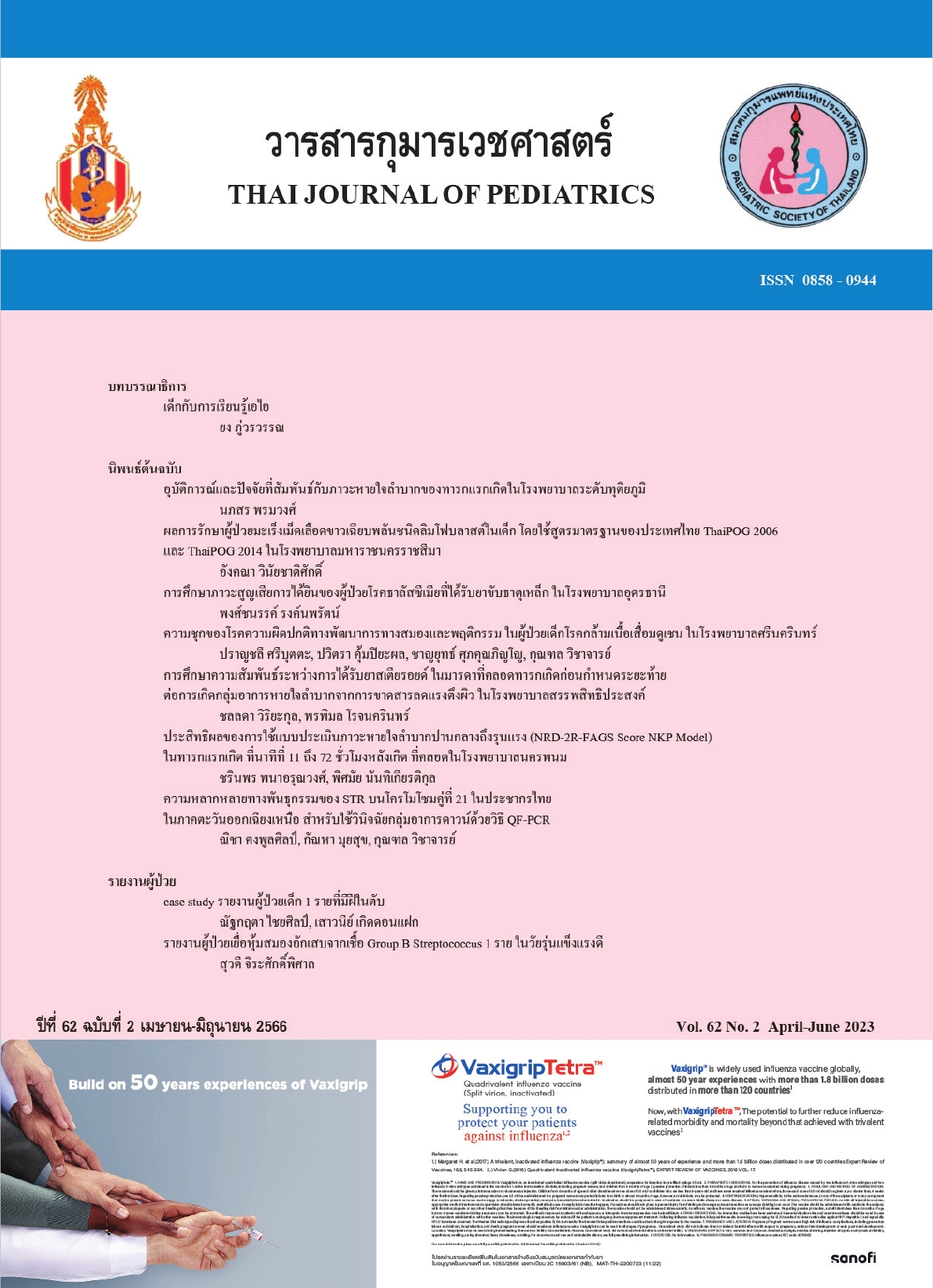ประสิทธิผลของการใช้แบบประเมินภาวะหายใจลำบากปานกลางถึงรุนแรง (NRD-2R-FAGS Score NKP Model) ในทารกแรกเกิด ที่นาทีที่ 11 ถึง 72 ชั่วโมงหลังเกิด ที่คลอดในโรงพยาบาลนครพนม
คำสำคัญ:
แบบประเมิน NRD-2R-FAGS Score NKP Model, ทารกแรกเกิด, ภาวะหายใจลำาบากบทคัดย่อ
การศึกษานี้เป็นการวิจัยกึ่งทดลอง (Quasi-Experimental Research) ศึกษาเชิงประสิทธิภาพ (Efficacy Research) รูปแบบ Retrospective interrupted times มีวัตถุประสงค์เพื่อศึกษาเปรียบเทียบการตรวจพบ ภาวะหายใจลำบากปานกลางถึงรุนแรงในทารกแรกเกิดก่อนและหลังการใช้แบบประเมิน NRD-2R-FAGS Score NKP Model ที่พัฒนาขึ้นศึกษาในทารกแรกเกิดที่มีภาวะหายใจลำบากที่อายุนาทีที่ 11 ถึงอายุ 72 ชั่วโมงหลังเกิดในโรงพยาบาลนครพนมจำนวน 304 ราย เลือกกลุ่มตัวอย่างแบบเฉพาะเจาะจง ระหว่างเดือนกันยายน พ.ศ. 2561ถึงกุมภาพันธ์ พ.ศ.2562 เป็นกลุ่มควบคุม 152 ราย และระหว่างเดือน กันยายน พ.ศ. 2562 ถึง กุมภาพันธ์ พ.ศ. 2563 เป็นกลุ่มทดลอง 152 รายวิเคราะห์ลักษณะทั่วไปด้วย t test และ exact probability test วิเคราะห์น้ำหนักตัว, ภาวะหายใจลำบากปานกลางถึงรุนแรง, Respiratory Distress Syndrome (RDS), Apgar Score ที่ 1 นาที,ที่ 5 นาที และเวลาที่ตรวจพบด้วย multivariable risk different regression กำหนดระดับนัยสำคัญเท่ากับ 0.05 ผลการวิจัยพบว่าลักษณะทั่วไปของทั้งสองกลุ่ม คล้ายคลึงกัน แต่พบมีน้ำหนักตัว (p=0.021), ภาวะหายใจลำบากปานกลางถึงรุนแรง (p=0.018), RDS (p=0.006), Apgar Score ที่ 1 นาที (p=0.008) และ Apgar Score ที่ 5 นาที (p=0.005) แตกต่างกันอย่างมีนัยสำคัญทางสถิติ แต่ไม่มีผลต่อการใช้แบบประเมิน จากการศึกษานี้พบว่าการใช้แบบประเมิน NRD-2R-FAGS Score NKP Model สามารถตรวจพบภาวะหายใจลำบากปานกลางถึงรุนแรงได้เฉลี่ย เร็วขึ้น 2.7 นาทที่ห้องคลอด (p=0.020) และตรวจพบมากขึ้นจากเดิมเฉลี่ย 4.16 เท่า (p=0.020) ที่ห้องคลอด
Downloads
เอกสารอ้างอิง
ชรินพร พนาอรุณวงศ์. ภาวะความดันเลือดปอดสูง ในทารกแรกเกิดในโรงพยาบาลนครพนม. วารสาร โรงพยาบาลนครพนม. 2560: 2: 5-11.
งานเวชระเบียนและสถิติโรงพยาบาลนครพนม. สถิติจำนวนผู้ป่วยกลุ่มทารกแรกเกิดนาทีที่ 11 ถึงอายุ 72 ชั่วโมงหลังเกิด ที่คลอดในโรงพยาบาล นครพนมและเข้ารับการรักษาในโรงพยาบาล นครพนม. 2561.
Ankush K, Rajendra B, Jayant V, Bhavana L, Rewat M, Amar T. Study of respiratory distress in newborn. Int J Contemp Pediatr. 2017: 4(2): 490-4.
Hermansen CL, Mahajan A. Newborn respiratory distress. Am Fam Physician. 2015: 92(11): 994-1002.
Christinal L, Hermansen, Anand M. Newborn respiratory distress. American Famaly Physician. 2015: 92(11): 994-1002.
Arun K, Pramanik, Nandeesh R, Thomas G. Neonatal respiratory distress a practical approach to its diagnosis and management. 2015: 62(2): 453-69.
Suzanne R, Chuanpit M., Michelle B. Respiratory distress in the newborn. American Academy of Pediatrics. 2014: 35:417-29.
Reuter S, Moser C, Baack M. Respiratory distress in the newborn. Pediatr Rev. 2014: ;35(10): 417-28.
Noah H, Alan H. J. Noninvasive strategies for management of respiratory problems in neonates. American Academy of pedriatic. 2013: 14 (5): 227-36.
Nagendra K, Wilson CG, Ravichander B, Sood S Mrs, Singh SP. Incidence and etiology of respiratory distress in newborn. Med J Armed Forces India. 1999:55(4): 331-3.
Anwaar O, Hussain M, Shakeel M, Ahsan Baig MM. Outcome of use of nasal continuous positive airway pressure through infant flow drivers in neonates with respiratory distress in a tertiary care hospitaliIn Pakistan. J Ayub Med Coll Abbottabad. 2018: 30(4): 511-5.
Pandita A, Murki S, Oleti TP, et al. Effect of nasal continuous positive airway pressure on infants with meconium aspiration syndrome: A randomized clinical trial. JAMA Pediatr. 2018: 172(2): 161-5.
Juan ED, Nynke VB. Continuous positive airway pressure (CPAP) to treat respiratory distress in newborns in low- and middleincome countries. Tropical Doctor. 2017: 47(1): 19-22.
Veronica M, Elena P, Elisabetta L, et al. Heated, humidified high-flow nasal cannulae as a form of noninvasive respiratory support for preterm infants and children with acute respiratory failure. Am J Perinatol 2016: 33(11): 1058-61.
ดาวน์โหลด
เผยแพร่แล้ว
รูปแบบการอ้างอิง
ฉบับ
ประเภทบทความ
สัญญาอนุญาต

อนุญาตภายใต้เงื่อนไข Creative Commons Attribution-NonCommercial-NoDerivatives 4.0 International License.



